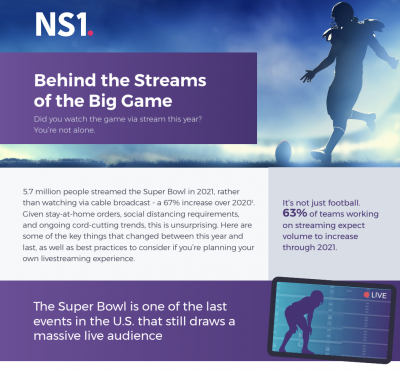Are you planning to stream the Super Bowl at home this year? If so, you’re not alone. A record 3.4 million people streamed the game in 2020 - a 23% increase over 2019.
For the event broadcaster - such as Fox, who we partnered with to livestream the game in 2020 - providing a stellar viewer experience is increasingly critical. A growing percentage of their viewers are accessing the game via stream, not traditional broadcast. Viewers expect the live stream to:
- Be synchronized with the cable broadcast (even a lag of 30 seconds can become apparent with social media feeds covering every big play, debated ref call and funny ad)
- Match the quality of the broadcast (Fox, for example, streamed the game in 4K HDR for the first time last year)
- And work no matter how they access it, whether that’s via smart TV app, streaming platform, computer, table, smartphone, etc.
So how do companies like Fox meet these expectations? In short, they build out a robust, next-generation tech stack - which includes our intelligent traffic steering solution, Pulsar. Here’s how we worked with them last year to bring the game to your TV, phone, tablet, or wherever you watched it.

Live streaming is on the rise: 5.7 million viewers streamed the Super Bowl in 2021
63% of streaming providers expect the volume to keep growing - learn more about other streaming trends in our infographic
What Goes Into Livestreaming the Big Game?
There are many components involved in delivering a successful livestream. Two key components are implementing a multi-CDN infrastructure and automating traffic steering using a solution like Pulsar. With a multi-CDN strategy, you can ensure there is enough bandwidth to handle peak viewership, as well as provide redundancy if an outage occurs mid-event. When paired with automated traffic steering, you can ensure great performance for your users while not going over capacity reservations with your CDN partners. We go into more detail about the different ways you can configure traffic steering policies for optimal performance in our post, How to Successfully Deliver a Large Scale, Livestream Event.
For last year’s game, some of the specific technical requirements we had to meet were:
- Cloud co-located HTTP
- Decision making of which of 5 CDNs to send the user to at start of the stream
- 50ms budget for HTTP-based decision
We embedded a Pulsar javascript within the primary streaming webpage, as well as a secondary webpage that was also expected to be highly trafficked.The javascript measured the equivalent of one HD video segment. That data was fed into our decision engine, the Filter Chain. The Filter Chain is highly customizable, but in this instance we set some of the following parameters:
- “Kill switch” to immediately avoid any CDNs that were down or experiencing issues
- Weighted shuffle - assign a weight to each CDN to split user traffic (i.e., send 30% to one CDN, 40% to another, and so on)
For a more detailed look at our work on the 2020 Super Bowl, check out NS1 Principal Engineer James Royalty's 2020 INS1GHTS session. He gives a play-by-play of how we used Pulsar to ensure an optimal viewer experience.
We also utilized our Pulsar Stabilize functionality, which eliminates poor performing CDNs based upon a preset threshold. It essentially works as an “insurance policy” to the other filters, as it can “edit” other filters to drive traffic based upon real-time conditions. This prevents flapping and keeps all viable options open. Over the course of the event, we saw approximately 60 million total requests, with an average HTTP response time of 4ms at 99th percentile. Fox was able to use that and other data collected by Pulsar to refine their strategy for future events.
Of course, the growing importance of livestreaming is bigger than just football. Streaming volume is only expected to increase across the board given longer term trends around digital-first experiences - think of the growing popularity of eSports, for example. 63% of teams managing live streams expect volume to increase through 2021, according to a recent survey we conducted with Dan Rayburn. To learn more about how these teams are preparing to meet this increased demand, download our full report: Growing Demands for Video Streaming Drive Companies to Intelligent Traffic Management Solutions.